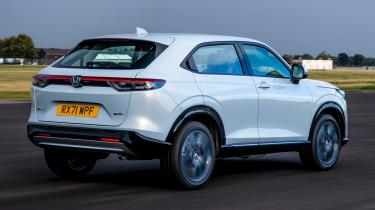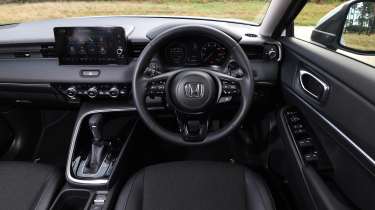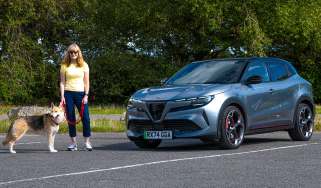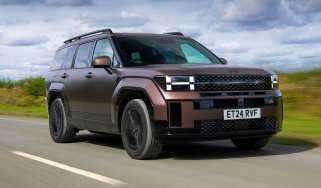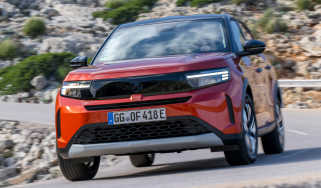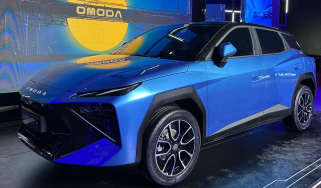Used Honda HR-V (Mk3, 2021-date) buyer’s guide: small SUV suits the city
A full used buyer’s guide on the Honda HR-V covering the HR-V Mk3 that’s been on sale since 2021
Verdict
The small SUV segment is busy, and the Honda HR-V doesn’t lead the class in any way, but that’s not to say it isn’t a good buy. If you do mainly local or urban driving, the HR-V could be just what you’re looking for. It’s frugal, well equipped and reliable, plus its roomy cabin makes it great for carrying people, even if its boot is among the smallest in the class. We ran an HR-V on our long-term fleet and really liked it, but in group tests the Honda has been beaten by the Hyundai Kona and Renault Captur, which is why we’d consider a few alternatives alongside Honda’s offering.
Few people remember Honda’s original HR-V of 1999, which was a neatly styled compact SUV that stood out from the crowd.
Unfortunately, the second-generation HR-V of 2015 was more conventional and struggled to catch the eye in a competitive segment.
So it’s good that when the Japanese manufacturer’s latest iteration appeared four years ago, it once again looked smart and desirable in what was by then a saturated sector.
However, while the HR-V Mk3 features a stylish, sophisticated exterior, and comes with an efficient hybrid powertrain, just how capable is it when there are so many talented rivals to choose from?
History
Orders opened for the HR-V Mk3 in August 2021. There was only one powertrain: a 129bhp 1.5-litre non-turbo petrol engine, backed up with hybrid tech. This was essentially carried over from the Jazz Mk4, but with a 25 per cent-bigger battery.
Used - available now
That power (along with 253Nm of torque) was sent to the front wheels via a continuously variable automatic transmission.
In September 2024 a facelifted HR-V went on sale, but changes were slight. Aside from a tweaked nose design, buyers got revised rear lighting, additional exterior colours, privacy glass as standard across the range, and a redesigned centre console. It also brought a new range-topping trim: Advance Style Plus.
On the road
The HR-V is very easy to drive, but the limited torque from the non-turbo engine means things can get pretty raucous when you accelerate.
There are three driving modes available – Eco, Normal and Sport – and these make a big difference to the weight of the steering and the throttle response. Overall, the handling is inert but the payback is a ride that’s comfy, even though the HR-V is composed on twisty roads.
Which should I buy?
All HR-Vs are identical mechanically, so it’s just a question of choosing a colour and a trim level.
About half of used HR-Vs for sale are mid-range Advance editions, with entry Elegance and range-topping Advance Style each accounting for about a quarter of the cars available.
Even the Elegance comes with navigation, heated front seats, keyless entry, a rear-view camera and parking sensors front and rear. Advance adds blind-spot warning, heating for the windscreen and steering wheel, dual-zone climate control, plus synthetic leather trim. The Advance Style also has wireless phone charging, a contrasting roof colour, unique colours, an upgraded hi-fi and smoked rear light lenses.
Alternatives to the Honda HR-V
The Ford Puma leads the class dynamically; it’s also roomy and has plenty of standard tech. The Renault Captur is another favourite with its economy and practicality, while the SEAT Arona, Skoda Kamiq and Volkswagen T-Cross are essentially all the same car with good engines, excellent tech and impressive build quality.
Also related to each other are the Citroen C3 Aircross, Peugeot 2008, DS 3, Jeep Avenger and Vauxhall Mokka, while this segment also features the Ford EcoSport, Hyundai Kona, Kia Stonic, MINI Countryman and Nissan Juke; we’d take the Puma over the EcoSport every time.
What to look for
Flat out
Some owners have had problems with the 12-volt battery going flat after leaving their car parked up, such as while on a two-week holiday.
Video nasty
Drive Recorder is the official dash cam, which can be fitted by Honda dealers. It links to an app on your phone, but many newer phones won’t connect.
Going spare
All HR-Vs come with a tyre repair kit rather than a spare wheel. There’s nowhere to store a spare wheel because the battery pack sits under the boot floor.
Peace of mind
The HR-V comes with a warranty that lasts for three years or 90,000 miles from new. Alongside this main warranty is a separate one for the battery, which is guaranteed for five years or 90,000 miles.
Interior
The cabin is a strong point, largely because of Honda’s unique Magic Seat feature. The cinema-style back seat flips up or folds flat and it massively increases the car’s versatility, which is just as well because the boot is disappointingly small with a capacity of just 335 litres, or 1,305 litres with the seats down.
Rear-seat space is good, at least for two; you can get three in there, but it’s a squeeze. Honda has provided masses of front-seat adjustment and the cabin quality is excellent, while the infotainment is easy to understand and the stereo sounds good. Even better, many HR-Vs have light-coloured trim, which makes the cabin feel even more spacious, although it does get grubby far too easily.
Prices
Buying a used Honda HR-V won’t come cheap due to the fact oldest examples are only a few years old. Advance models are more expensive than Elegance, but this can offset by buying an older example of the former. Buy new and discounts are readily available.
Check the price of a Honda HR-V with our free car valuation tool...
Running costs
All HR-Vs need to be serviced every 12 months or 12,500 miles. The first service is priced at £285, with the second and third each costing £335, and once an HR-V is four years old it’s entitled to discounted maintenance.
From this point on, services alternate between Minor and Major at £240 and £350, with replacement coolant required after 10 years or 125,000 miles, then every five years or 62,500 miles, at £130. The HR-V’s engine is chain driven, so there’s no cambelt to replace.
Insurance ratings are high at 32 or 33; that’s the same as a Mercedes-AMG A 35 or a Volvo XC90 D5 Momentum. But your fuel bills should be low; it isn’t hard to average more than 50mpg unless you’re driving on the motorway a lot, in which case 42mpg is a more realistic average.
Recalls
While the HR-V Mk2 (on sale from 2015 until 2021) was subject to four recalls in two years (autumn 2018 through to autumn 2020), so far the third-generation HR-V has been involved in just one campaign.
This was issued in October 2024 and it affected 4,674 cars built between January 2021 and January 2022. It was all down to the Brake Operating Simulator (BOS) unit, which controlled the braking system. This could go on the blink, leading to a lack of braking assistance, as though the servo had failed.
This could potentially lead to extended pedal travel too, and the solution to the problem was to replace the BOS in its entirety.
Driver Power owner satisfaction
Honda is a niche player in the UK with just over 30,000 sales last year across its entire range. As a result, there were no Hondas in the 2024 Driver Power survey and just one (the Jazz) in 2023. That came 32nd out of 75, while in the brands survey, Honda was rated 11th out of 32.
Did you know you can sell your car with Auto Express? Get the highest bid from our network of over 5,500 dealers and we'll do the rest. Click here to try Auto Express Sell My Car now...
Used Honda HR-Vs for sale

2017 Honda
HR-V Hybrid
20,870 milesAutomaticPetrol1.5L
Cash £14,739
2024 Honda
HR-V Hybrid
4,287 milesAutomaticPetrol1.5L
Cash £20,949
2024 Honda
HR-V Hybrid
14,773 milesAutomaticPetrol1.5L
Cash £21,732
2024 Honda
HR-V Hybrid
14,281 milesAutomaticPetrol1.5L
Cash £21,375
2020 Honda
HR-V Hybrid
7,501 milesManualPetrol1.5L
Cash £16,161
2020 Honda
HR-V Hybrid
27,310 milesAutomaticPetrol1.5L
Cash £14,750
2024 Honda
HR-V Hybrid
20,606 milesAutomaticPetrol1.5L
Cash £20,800
2020 Honda
HR-V Hybrid
54,975 milesManualPetrol1.5L
Cash £12,700
2024 Honda
HR-V Hybrid
20,638 milesAutomaticPetrol1.5L
Cash £21,495


